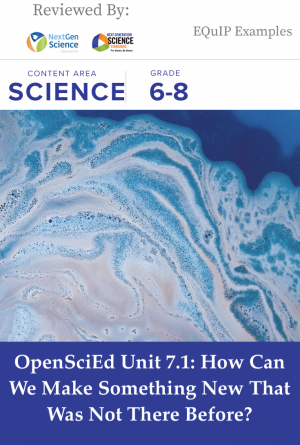
OpenSciEd is a nonprofit organization that brings together educators, philanthropic organizations, curriculum developers, and professional development providers to improve science education through the development and implementation of high-quality, freely available science instructional materials. While this work has begun at the middle school level with Grades 6 through 8, the goal of OpenSciEd is to ensure that all educators, from elementary to high school, have access to a free, coherent, rigorous, research-based set of instructional materials that will support all students in meeting the vision for science literacy described in A Framework for K-12 Science Education and the Next Generation Science Standards.
Score: 8
Awarded the NGSS Design Badge
Science Discipline: Life Science, Physical Science
Length: Unit
Year Reviewed: 2020
This unit on chemical reactions and matter transformations begins as students explore what happens when a bath bomb is added to water. Students develop a model to explain what they think happens to the matter that was in the bath bomb and what causes the gas bubbles to appear. This experience and related phenomena lead to a broader set of students’ questions around: How can we make something new that was not there before?
Throughout this unit, students analyze data about the bath bomb, including what happens to the amount of matter in the bath bomb before, during, and after gas bubbles appear, and the properties of the substances that make up the bath bomb, the water, and the gas that is produced.
Students develop models to account for how new types of particles can be appearing from old particles. They compare their models to historical models developed by Dalton and other scientists, and they conduct investigations on water to determine if it has undergone a physical change or a chemical reaction.
Embedded in this unit are a variety of assessments, including self, peer, formative, and summative assessment tasks. This unit concludes with a transfer task in which students apply what they have figured out to two different related phenomena, elephant’s toothpaste and the crumbling of the marble that makes up the Taj Mahal.
Link to Materials
The following link will direct you to OpenSciEd’s Unit 7.1 Unit Overview Page: OpenSciEd Unit 7.1: How Can We Make Something New That Was Not There Before?
The NGSS Design Badge is awarded only to the version of this unit that was reviewed. If any modifications are made to this unit, the revised version cannot be promoted as having earned the badge.

 Reviews & Questions
Reviews & Questions
No comments submitted